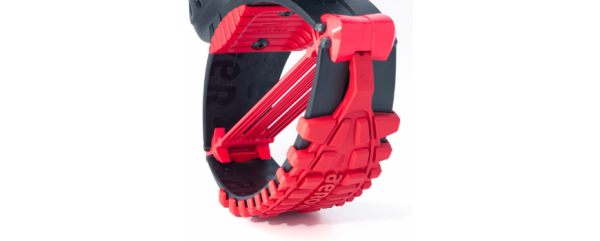Are jumpers or rebound boots safe?
The short answer that anyone who has tried them would give is very clear: YES. But here you can find the full explanation. So that you too will be encouraged to try them, achieve all your goals with them and can say loud and clear: jumpers are safe!
Stability
Let's start with something that often worries people who have never tried rebound shoes before: are the jumpers stable? Will I fall off if I wear rebound boots? It is actually very difficult to fall off when standing up in them.
The reason is that, contrary to what you might think, the Rebound System (RS) forms a very stable base. First of all, the RS is designed in such a way that it is always wider than the boots to which it is attached. As you know, the Aerower RS is compatible with boots from other brands. And, yes, it is also designed to form a stable base with them. The fact that the RS is wider than the boots, whatever your size, ensures lateral stability. That is, it prevents us from having to hold our balance so as not to fall sideways.
Secondly, (and here the Aerower Jumper1 is unique) there is also the oscillation caused by the fact that the lower arc forms a curved surface. When designing the Aerower Jumper1, its creator, Carlos Peydró, incorporated 4 retractable bumpers into the sole to prevent this oscillation, and this is just one of the more than 10 technologies and systems that are exclusive to the Jumper1!
So when we are standing still, the Jumper1 forms a very stable base. During exercise, the pressure we exert when jumping incorporates the bumpers into the natural curvature of the sole so as not to affect the rebound.

Ankles
Now that we have clarified why jumpers (also called rebound boots) are stable, let's dispel another of the most widespread doubts among people who have not yet tried them. Are jumpers dangerous for the ankles?
Certainly the ankles are the first joint to be taken into account when we talk about any type of boot. In the case of jumpers, and more clearly with the Aerower Jumper1, this question is totally solved. In fact, ankle protection is the main reason why rebound boots are the way they are (very similar to a skate or even a ski boot): semi-rigid and wide.
Being semi-rigid, the ankle is always held in the right position and it is impossible for it to twist. And because they are wide, the mobility of the ankle is ensured, so that it is not blocked, which would also cause problems.
So when choosing your Jumper1, always bear in mind this advice from Aerower and Jumple Academy: when checking your jumper size, if in doubt between two sizes, it is always best to choose the larger one. The triple locking system will ensure the perfect fit for your foot.
Know all the steps to choose my Jumper1
Likewise, every time you put on your Jumper1, to know that you have left the perfect width, you should be able to insert two fingers between your ankle and the boot, as shown in the following image.

The most suitable mobility is assured for the ankles, but also comfort? Of course! In fact, the last improvement launched for this type of sports footwear by Aerower has been in this sense. It is the J1+ liner. The liner prevents any kind of chafing on the ankle and ensures total comfort. In the case of the J1+ liner, reinforcements have been incorporated in the most sensitive parts of our feet, ankles and insteps, among other changes aimed at making them more durable and hygienic. You can learn more about the improvements of the J1+ liner here.
Therefore, the conclusion is clear: your ankles will be 100% protected, in a boot with which we feel at the same time the perfect support and the most pleasant comfort.
Falls
Stability assured, ankles well protected, but is it easy to fall off with jumpers? Many people dare to try on a pair of jumpers or rebound boots, but are wary of jumping, bouncing or jogging in them.
The best test is to put them on and experience for yourself that it is practically impossible to fall when wearing jumpers, of course. But beforehand there are a few reasons that can help us to be confident if we are a little apprehensive.
The first thing to keep in mind is that with jumpers we don't get too high off the ground. The height of the RS is approx. 15 cm, which is much lower than, for example, climbing on a trampoline. Jumper trampolines are also a much more stable base than a trampoline, for the reasons explained above.
In addition, we must bear in mind that, when jumping with jumpers, although the feeling of momentum is very motivating, we only separate from the ground about 5 cm. Remember that the main benefit of jumpers is shock absorption (up to 80% with the RS set up correctly). Taking advantage of their momentum with big jumps is only for people with a certain amount of practice who are looking to have fun and get a lot of photo-boosts.

It's just a matter of gaining confidence little by little. When you try them out for the first time, walk around a bit with them and then start jumping up and down on one foot or the other. In just a few minutes you'll have tested the stability of the Jumper1 and you'll be ready for a Jumple class. The motivation of bouncing, the feeling of weightlessness, will be an unbeatable motivation.
Ensures good technique
By exercising with jumpers, we will have outstanding protection for our joints and we can enjoy the motivation of jumping while achieving multiple benefits. But we can enhance all of this and ensure success with good technique.
Some basic tips are:
Have our Jumper1 perfectly personalised.
Try to always step in the centre of the RS.
Maintain good posture and body alignment.
Warm up and stretch at the beginning and end of each session.
Etc.
The best thing in this case, of course, is to count on the best professionals in the discipline. In this case, these are the instructors trained by Jumple Academy. The reason is very clear: it is the only training institution in the sector that continues to work on research and keeps its training programmes up to date with the latest scientific studies and the most current trends in fitness and sports training.
This is why Jumple training programmes are designed for the progression of each student, from level zero to professional levels. In fact, in the same Jumple class, you can work on several levels at the same time, each one with a training plan adapted to their level.
Ask us by sending an email to jumple@jumpleacademy.com!

Precautions
Finally, like any other type of physical activity, there may be some precautions or adaptations that we should make for our specific case. For example, if you usually have insoles to correct pronation or supination, you should also include them inside your Jumper1. It is important to maintain the correct distribution of forces in all our jumps with jumpers.
Likewise, all Jumple professionals are aware of the relative and absolute contraindications for exercise with jumpers and each type of activity. Absolute contraindications are those that unfortunately do not allow us from exercising with jumpers, although they are very few: cranio-vertebral instability, retinal detachment, pregnancy or being under the influence of alcohol or drugs.
Relative contraindications are those that may pose a risk to exercise with jumpers. For example, some kind of disability. For these cases, it is sometimes necessary to make some adaptations so that the person can participate safely, or even work together with the health professional in charge of the case. This is why Jumple professionals have documents such as the "PAR-Q Jumple" or the "Medical Consent Jumple". The "PAR-Q" is a questionnaire to detect any contraindications and the "Medical Consent" contains the necessary information so that any physician can know what the activity consists of and give his or her recommendations.
Start jumping with jumpers
Getting my jumpers the cheapest and fastest way
What are the best jumpers for me?
Ask for your nearest instructor
Steps to start jumping with jumpers
We are waiting for you in our networks to share great moments together!

